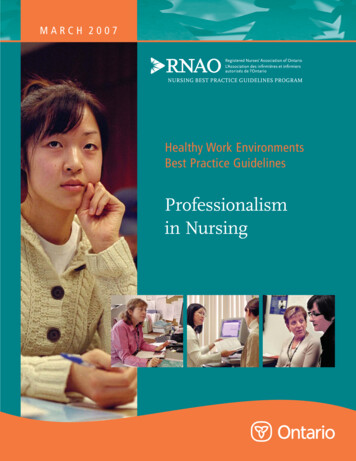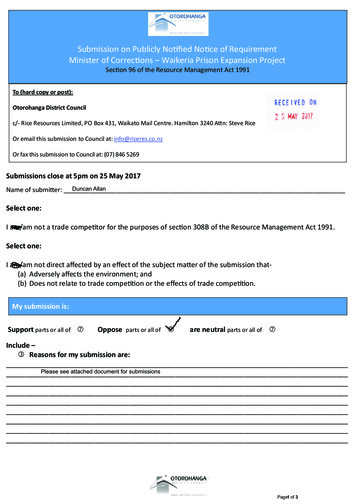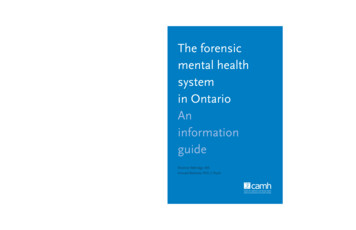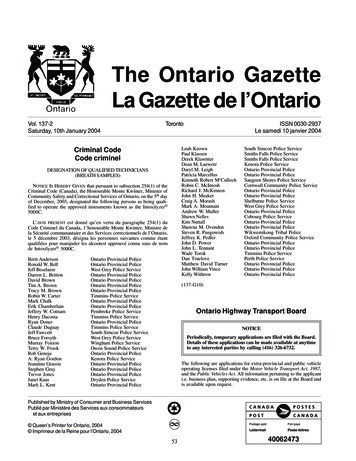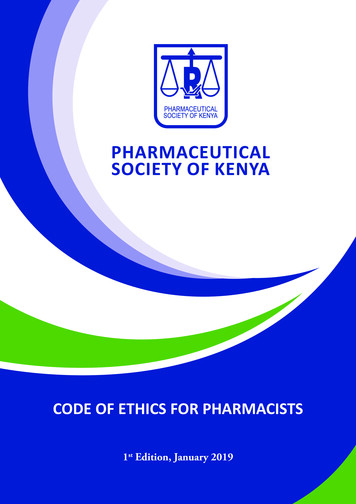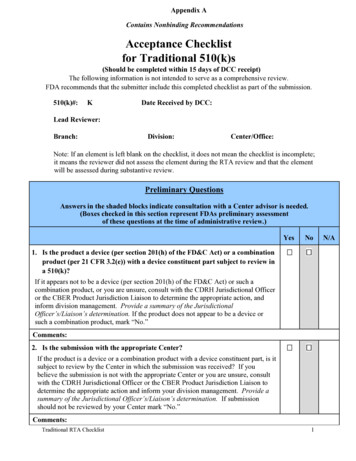
Transcription
Ontario College of Pharmacists483 Huron StreetToronto, ON M5R 2R4Ontario College of Pharmacists Submission to theMinistry of Labour:Consultation on Employment Standards ActExemptions for PharmacistsFebruary 2018Ontario College of Pharmacists Submission to the Ministry of Labour:Consultation on Employment Standards Act Exemptions for Pharmacists1
Table of ContentsI. Executive Summary . 3II. Introduction . 4III. Background . 4A. Ontario College of Pharmacists . 4B. Pharmacist Practice in Ontario . 5IV. Methodology and Limitations . 5A. Online Consultation . 5B. Focus Groups. 6C. Omnibus Survey . 6V. Summary of Results from the Consultations Conducted by the College. 7A. Findings from the Online Consultation . 7B. Results of the Omnibus Survey and Focus Groups . 9C. Key Findings . 9VI. Review of Ontario Regulatory Register Responses . 10VII. Recommendations and Considerations . 10VIII. Conclusion . 12IX. Appendices . 12Appendix 1: Responses Received Through the Online Consultation . 12Appendix 2: OCP Ontario Omni Report December 18, 2017 . 12Ontario College of Pharmacists Submission to the Ministry of Labour:Consultation on Employment Standards Act Exemptions for Pharmacists2
I. Executive SummaryThe Government of Ontario has been consulting with key stakeholders and seeking public inputon current exemptions, special rules or exclusions under the Employment Standards Act, 2000(ESA). As part of its review, and mindful of the Ontario College of Pharmacists’ (“the College’s”)mandate to serve and protect the public, the Ministry of Labour asked the College to provide asubmission on whether the current pharmacist exemptions under the ESA should bemaintained.The College undertook consultation activities with both pharmacists and members of the publicwith a focus on the impact of removing or maintaining the exemptions on the safety and qualityof patient care and access to pharmacy services.In analyzing and summarizing the responses, the College found the following: The majority of respondents, both members of the public and pharmacists, supportremoving or modifying the ESA exemptions. Many pharmacists believe that doing sowould have positive impacts on patient care. There was no strong consensus from thepublic as to whether removing the exemptions would have an overall positive ornegative effect on the safety and quality of patient care. Comments were provided by both the public and pharmacists which suggested concernthat long working hours of pharmacists could increase the risk of error and therefore bedetrimental to patient safety. Pharmacists were primarily concerned with the exemption related to eating periods andhours of work as it was reported to have the most impact on how they provide patientcare. While some respondents felt that removing these exemptions could result in apharmacy needing to close to accommodate a pharmacist’s break and as a result affectaccess to pharmacy care, many others felt that patients have adequate choice ofpharmacies if their own was closed for a short period.In light of the feedback received by the College and in line with the College’s role as theregulator of pharmacy dedicated to serving in the public interest, the College recommends thatthe Ministry consider the following in their review: The degree to which the impact of removing exemptions (or a sub-set of them) mayresult in greater patient safety through a potential reduction in the risk of errors. The extent of the impact of removing exemptions on timely access to pharmacyservices, especially in rural communities.Ultimately, when considering any changes to legislation or expectations of pharmacies andpharmacy professionals, it is the College’s position that patient safety must be the foremostpriority. Furthermore, any changes made under the ESA must not act as a barrier to pharmacistsproviding patient care in accordance with legislation, standards of practice, the Code of Ethicsand College policies and guidelines.Ontario College of Pharmacists Submission to the Ministry of Labour:Consultation on Employment Standards Act Exemptions for Pharmacists3
II. IntroductionThe Ministry of Labour is conducting a review of the special rules and exemptions under theESA. The ESA sets out the rights and responsibilities of employees and employers in mostOntario workplaces and provides the minimum standards for most employees working inOntario.Pharmacists are currently exempt from certain areas of the ESA, including hours of work andeating periods, overtime pay, minimum wage, public holidays, vacation with pay and personalemergency leave. The College, in its capacity as the regulator of pharmacy in the province, wasasked to provide the Ministry of Labour with a written submission on whether the profession’sexemptions from the ESA should be maintained as they relate to pharmacists.Three consultation activities informed this submission: An online consultation portal on the College website between November 20 andDecember 15, 2017 to get input from the public and pharmacists. Discussion with four focus groups comprised of individuals – general public – fromacross Ontario and moderated by an external research and polling group. Questions included within a weekly omnibus survey directed to approximately 1,000Ontarians, done by the same external firm.Taking an approach that aligns with the role of the College to regulate the practice of pharmacyin Ontario along with its mandate to serve and protect the public interest, the scope of theconsultations conducted by the College were specific with respect to patient and public safety.In all cases, respondents were asked to consider the impact of removing or maintaining theexemptions for pharmacists in the context of access to pharmacy services and the quality andsafety of pharmacy care.While the Ministry requested information and feedback related to pharmacists who areemployees, rather than independent contractors or employers, it was not possible for theCollege to separate responses from pharmacists into the different categories. Thus, allresponses that were received through the online consultation are reflected in the findingsbelow.The College also reviewed the input related to pharmacists submitted by professionalassociations to Ontario’s Regulatory Registry from October 18, 2017 to January 1, 2018. Theirfeedback is addressed separately in the report.III. BackgroundA. Ontario College of PharmacistsThe Ontario College of Pharmacists regulates pharmacies, pharmacists and pharmacytechnicians in the province of Ontario. The College’s mandate is to serve and protect the publicand hold Ontario’s pharmacists and pharmacy technicians accountable to the establishedlegislation, standards of practice, Code of Ethics and policies and guidelines relevant topharmacy practice. The College also ensures that pharmacies within the province meet certainstandards for operation and are accredited by the College.Ontario College of Pharmacists Submission to the Ministry of Labour:Consultation on Employment Standards Act Exemptions for Pharmacists4
B. Pharmacist Practice in OntarioThere are over 15,000 pharmacists registered to practice in Ontario. Most pharmacists work incommunity or hospital pharmacy providing direct patient care. Pharmacists in the communityare often the most accessible and convenient healthcare professional for patients.The practice of pharmacy is the promotion of health, prevention and treatment of diseases,dysfunction, and disorders through medication and non-medication therapy; the monitoring andmanagement of medication therapy; the custody, compounding, and dispensing of drugs; andthe provision of healthcare aids and devices and information related to their use. Pharmacistshave a unique body of knowledge respecting drugs and drug actions, interactions, and effects,based on their extensive education and training in such areas as medicinal, physical, biological,and pharmaceutical chemistry, anatomy, physiology, biopharmaceutics and pharmacokinetics,therapeutics, pharmacology, and pathology.In recent years, the pharmacist’s role in the health care system has expanded to include servicesbeyond dispensing medication and counseling patients on their drug therapy. Since October2012, expanded scope has allowed pharmacists to provide services that include prescribingcertain drugs and administering certain vaccines. Pharmacists also initiate therapy for smokingcessation to promote healthy lifestyles, and administer flu shots through the province’sUniversal Influenza Immunization Program. There is also an increasing role for pharmacists toplay in confronting and reducing the harms of ongoing healthcare issues such as the opioidcrisis.Pharmacists are expected to practice in accordance with the Code of Ethics, relevant legislationand policies and the standards of the profession. They must also abide by the Model Standardsof Practice for Canadian Pharmacists (MSOPP) and the Supplemental Standards of Practice forSchedule II and III Drugs. These standards outline the responsibilities of a pharmacist, includingpharmacists managing a pharmacy.The Standards of Accreditation under the Drug and Pharmacies Regulation Act, 1990 outline theresponsibilities of the designated manager, owner and directors when operating a pharmacy.The standards, taken together, create an overarching obligation on designated managers,directors and corporations to support the provision of quality services.IV. Methodology and LimitationsA. Online ConsultationA total of 384 responses through the College’s online consultation portal were evaluated. Tworesponses were identified as duplicate and were removed. Five responses did not meet theobjective of the consultation and were also removed, leaving 377 responses for analysis.A detailed analysis of the responses was structured based on various criteria, including type ofrespondent, whether they expressed support for maintaining or removing the ESA exemptions,and whether the respondent comments about the exemptions have an impact on the quality ofpharmacy services delivered to the patient or patient safety.Ontario College of Pharmacists Submission to the Ministry of Labour:Consultation on Employment Standards Act Exemptions for Pharmacists5
In addition, some of the responses were grouped into themes to provide a more in-depth andcontextualized insight into the workplace for pharmacists who currently have exemptions underthe ESA.The majority of responses (94%) in the online consultation came from pharmacists. Less thanfour percent of the online consultation responses identified as members of the public, which isconsistent with public consultations that the College has done in the past. The remaining twopercent were comprised of individuals working in the pharmacy who were not pharmacists aswell as those respondents who chose not to identify themselves.LimitationsWhile the College makes the consultation portal available to pharmacy professionals,stakeholders and the public, pharmacists generally make up the majority of responses toconsultations conducted by the College. This consultation was promoted through the College’ssocial media channels, website and email newsletter, in addition to some paid social mediaadvertising targeting the public.The responses from pharmacists, the public and other respondents should not be considered arepresentative sample, as respondents self-selected to participate. In addition, while the Collegeset out specific questions that respondents were asked to answer, respondents were able tocomment freely – ultimately, many provided anecdotes rather than clear statements of supportor disagreement for removing the exemptions. As well, it was not possible for the College toseparate responses from employee pharmacists from those of employers or owners.B. Focus GroupsFour focus groups were hosted by Leger, a well-known research firm. There were a total of 28participants of varying ages and income levels, with two groups conducted in person in Torontoand two conducted online with participants from across the province. All participants had used apharmacist a minimum of two times in the last six months. Respondents were provided thesame information regarding the ESA that was shown in the omnibus survey (see Appendix 2).LimitationsThe responses provided through the focus group should not be considered a representativesample. However, their comments were very helpful in illustrating public concerns around ESAexemptions for pharmacists.The four focus groups were originally established to consult on other aspects of the College’sactivities and therefore, discussions were not solely focused on the ESA exemptions.C. Omnibus SurveyA survey of 1,010 Ontarians was completed online between December 11 and 14, 2017 usingLeger’s online panel, LegerWeb. The College was able to include three questions specificallyregarding the exemption of pharmacists from the ESA (see Appendix 2 for the report fromLeger). Leger notes that a probability sample of the same size would yield a margin of error of /-3.0%, 19 times out of 20.Ontario College of Pharmacists Submission to the Ministry of Labour:Consultation on Employment Standards Act Exemptions for Pharmacists6
LimitationsRespondents to the survey had limited and high-level information provided to them regardingthe exemptions with no opportunity to seek clarity on any questions they might have.Additionally, there was no measure as to whether any of the respondents have regularly soughtthe services of a pharmacy.V. Summary of Results from the Consultations Conducted by the CollegeThe feedback obtained through the online consultation, the focus groups and the survey wasanalyzed and is summarized below.A. Findings from the Online ConsultationThe majority of respondents support removing or modifying the ESA exemptions forpharmacists.Fifty-seven percent of respondents supported removing the exemptions or suggestedmodifications to the exemptions. Respondents expressed varying degrees of support: somerespondents believed all of the exemptions should be removed, while others believed that theonly ESA exemptions that needed to be removed or modified were eating periods and hours ofwork.Approximately six percent of respondents supported maintaining the exemptions.Over one-third (37%) of respondents did not clearly comment on whether they supportmaintaining or removing the exemptions. Instead, they generally shared anecdotes or issuesthey have experienced in their practice that they felt were related to potential changes underthe ESA.The majority of respondents were concerned with hours of work and eating periods.Overwhelmingly, there was an expression of concern regardingthe impact the current exemptions have on the ability ofpharmacists to take breaks and to limit their working hours.Many pharmacists shared stories of when not being able to eator rest had negative effects on their own health and the carethey provided to patients.Public perspective:“I do not want someoneresponsible for mymedication to be sufferinglow blood sugar,dehydration, fatigue.”There were a few respondents who felt that, as professionals,pharmacists should make their own decisions about when totake breaks, and that the ESA is not an appropriate enforcement mechanism for this group ofprofessionals.Ontario College of Pharmacists Submission to the Ministry of Labour:Consultation on Employment Standards Act Exemptions for Pharmacists7
However, many pharmacists believed that unless mandated through law, employers will not feelthey need to provide coverage for breaks and eating periods. Respondents signaled that thisleaves them in a difficult position since a pharmacist must be available if the pharmacy remainsopen to the public.Other issues related to the exemptions, such as vacation pay and public holiday pay, were notdiscussed as frequently. Many pharmacists indicated that they already received these benefitsfrom their employers.The majority of respondents believe there would be a positive impact on the quality ofpharmacy services and safety of patients if the exemptions were removed, while recognizingthere may also be some unintended consequences.Seventy-seven comments were specific to the safety and quality of patient care and accessibilityof pharmacy services if the exemptions were removed. The majority of respondents believe thatthis impact would be positive, as access to breaks and other workplace entitlements wouldimprove working conditions, which many say would result in better patient care. Manyrespondents asserted that under the current exemptions there is a risk to patient safety,meaning a lower standard of patient care and increased medication errors, because they do notreceive adequate breaks and are scheduled for long or consecutive shifts.At the same time, respondents flagged the following potential unintended consequences: If there were no corresponding changes to the expectations of the employer in regardsto output and activities, the benefits of a break would be negated by feeling morerushed and pressured to fit the same amount of work into less time, paradoxicallyaffecting patient safety. The availability of timely service might decrease, particularly inrural areas and small pharmacies where only one pharmacist isemployed and the pharmacy needs to close when thatpharmacist is not present. However, there was not consensuson this point as some respondents stated that most patientshave many pharmacies within a short distance of each other,and many pharmacies are staffed by multiple pharmacists.Public perspective:“Patients don't have theluxury of time whencommuting longdistances.”Many respondents commented that the role of the pharmacist in the health care system haschanged since the ESA exemptions were first put in place.Many pharmacists commented that today they have a greater role in providing a range ofpharmacy services. They noted that pharmacy hours of operation are longer and they feelexpected to do more without the necessary staff to support them.Ontario College of Pharmacists Submission to the Ministry of Labour:Consultation on Employment Standards Act Exemptions for Pharmacists8
B. Results of the Omnibus Survey and Focus GroupsThe survey and focus groups were directed exclusively to the public.The majority of public respondents believe that pharmacists should not be exempt from thestandards in the ESA.The consensus from the focus groups along with 59% of Ontarianspolled in the survey, is that pharmacists should not be exempt fromthe standards in the ESA. Only one-quarter of respondents to thesurvey believe pharmacists should continue to be exempt.Public perspective:“These employees shouldbe eating, taking theirbreaks, taking vacation.”Public respondents expressed concern for people living in smaller communities who may notbe able to access a pharmacy when in need.Similar to the online consultation, public respondents signaled therisk of unintended consequences associated with removing theexemptions. Despite believing that pharmacists should not beexempt, there was some concern expressed for whether patientsliving in smaller communities would be able to access a pharmacywhen in need. Based on results from the survey, roughly four-in-tenOntarians agree that removing the exemptions would have anegative impact on access to timely pharmacy care. However,members of the focus group weren’t as worried as they felt peoplecould find alternative ways to access pharmacy care in thesesituations, such as by planning ahead or accessing an open pharmacynearby.Public perspective:“If you live in a small townand you go to your doctorlate in the day, you shouldstill be able to get yourprescription.”Public perspective:“If you are tired, you canmake a mistake. Theyshould have a certainnumber of hours.”Ontarians who responded to the survey were unclear overall on theimpact to the safety and quality of patient care of either maintainingor removing the exemptions, with about 40% saying that it wouldhave a negative impact and about 40% saying that it would have apositive impact.The impact of maintaining the exemptions was more clearly expressed in the focus groups.Participants expressed concern about the safety and quality of patient care they would receivewhen pharmacists were working too many hours.C. Key FindingsThe following highlights key findings from all three consultation activities. There is strong support, from both the profession and the public, for the removal ormodification of the exemptions for pharmacists under the ESA.The majority of pharmacist respondents believe that there would be a positive impacton the quality and safety of patient care if the exemptions were removed.Ontario College of Pharmacists Submission to the Ministry of Labour:Consultation on Employment Standards Act Exemptions for Pharmacists9
The public who participated in the focus groups were concerned about risks to theirhealth and safety due to pharmacist fatigue. However, in the survey there was noconsensus on whether the removal of the exemptions would have a positive or negativeimpact on the quality and safety of patient care.The major exemptions in the ESA that concerned pharmacists were related to hours ofwork and eating periods.There were some concerns around accessibility of pharmacy services if pharmacistswere granted eating periods and limits on hours of work that resulted in changes topharmacy hours of operation, especially in rural communities.Pharmacists are concerned that without accompanying structural or staffing changes,removing the exemptions could result in new patient safety and workload managementissues.VI. Review of Ontario Regulatory Register ResponsesThere were 22 responses submitted through the Ontario Regulatory Register; four responseswere from professional associations (representing business, retailers, pharmacies andpharmacists), one was a duplicate, and the remaining responses were from pharmacists.The responses from the professional associations were reviewed but are not reflected in thefindings above as the College was specifically requested to focus its consultation and analysis onemployee pharmacists and the public. However, the College did observe that the commentsfrom professional associations expressed concern over operational challenges and the economicimpact on businesses if the exemptions are removed. In general, the professional associationssupport allowing rest and eating periods for pharmacists as long as there is flexibility built intothe standards for meal breaks. They are concerned that there is a potential negative impact topatients if pharmacy operations are interrupted, suggesting that it is not practical to have asecond pharmacist available for coverage in a small pharmacy. Larger pharmacies use a team ofpharmacists who work extended hours but do not necessarily overlap shifts to allow forcoverage in the pharmacy.VII. Recommendations and ConsiderationsThe College’s mandate is to serve and protect the public interest. As such, the College’sconsultations on whether to remove exemptions for pharmacists under the ESA were focusedon potential impacts on safety, quality, and access to pharmacy care. Regardless of any changesmade to the ESA, the obligations of pharmacists to the Code of Ethics, the standards of practiceand applicable legislation and policy will be upheld. It is the College’s expectation that, nomatter the practice setting or business demands, pharmacists must provide care that puts thepatient first.Any changes to the ESA regarding pharmacist exemptions may also have unintendedconsequences on patient care, pharmacy operations and the pharmacy’s work environment. Indrafting the recommendations below, the College has described some of the potential impacts,based on the feedback received.Ontario College of Pharmacists Submission to the Ministry of Labour:Consultation on Employment Standards Act Exemptions for Pharmacists10
Therefore, the College recommends that the Ministry consider the following in its review: The impact of removing exemptions on public safety and the quality of pharmacyservices. Many pharmacists raised concerns that current conditions are contributing torisks for patients, for example by having pharmacists providing patient care when theyhave not had sufficient breaks for rest and eating. There were a number of respondentswho felt that removing the exemptions would lead to a decrease in the incidence or riskof medication errors, thus improving patient care. From the public perspective, manymembers of the focus groups were concerned about the risk of pharmacist error due tofatigue and long hours. The impact of removing exemptions on timely access to pharmacy services.Respondents were divided on whether removing the exemptions would affect patientaccess to care. Under the Drugs and Pharmacies Regulation Act, a pharmacy cannotoperate without a pharmacist physically present (unless the pharmacy has the ability torestrict the public from access to any drugs referred to as Schedule I, II or III). In urbanareas, there are generally many pharmacies and multiple pharmacists on staff andaccess may not be an issue. However, the Ministry may wish to consider the impact thatrequiring breaks or restricting hours of work could have on rural communities that onlyhave one pharmacy. There may be potential compromises to certain requirements; forexample, a pharmacist could be required to take a break, but has to remain physicallypresent in the pharmacy. The recognition by many pharmacists that they consider themselves primarilyemployees. Many pharmacists felt that while they were considered healthcareprofessionals, they were not independently able to make decisions about breaks, limitson hours of work and other benefits, which sometimes compromised their well-being.The Ministry may wish to consider whether a changing work environment means thatpharmacists are more often being treated as employees by their employers and notindependent professionals. The business models currently present in pharmacy. Unlike many other regulatedhealthcare professionals, pharmacists cannot manage patient volume through anappointment system. Many pharmacies function with only one pharmacist on duty atany given time, supported by pharmacy technicians and/or pharmacy assistants. Shouldpharmacists be required to take breaks, it may not always be feasible to providepharmacist coverage for that short period. This may mean that the pharmacy needs toclose for that period, which could restrict access to products beyond medications (e.g.food, wellness, personal care). Alternatively, the pharmacy may need to break up fulltime shifts into multiple swing or part-time ones. Either of these may result in negativeimpacts on patient access or continuity of care. The Ministry may wish to consider howremoving the exemptions could be done in a way that takes into account the variousbusiness models that exist in pharmacy.Ontario College of Pharmacists Submission to the Ministry of Labour:Consultation on Employment Standards Act Exemptions for Pharmacists11
VIII. ConclusionThis submission was informed by hearing from the public and pharmacists. While the College, asthe regulator of pharmacy in the public interest, does not hold a position on whether specificexemptions under the ESA should be removed, this report summarizes many of the issuesidentified with doing so and outlines potential impacts on patients, pharmacists andpharmacies.Ultimately, when considering any changes to legislation or expectations of pharmacies andpharmacy professionals, it is the College’s position that patient safety must be the foremostpriority.The College would be pleased to continue to work with the Ministry of Labour and other keystakeholders regarding the profession’s exemptions from the ESA to ensure that the safety andquality of and access to pharmacy care for patients is maintained or improved.IX. AppendicesAppendix 1: Responses Received Through the Online ConsultationA copy of the responses received through the College’s online consultation is available on theCollege’s website: Consultation on Exemptions and E
and hold Ontario’s pharmacists and pharmacy technicians accountable to the established legislation, standards of practice, Code of Ethics and policies and guidelines relevant to pharmacy practice. The College also ensures that pharmacies within the province meet certain s

